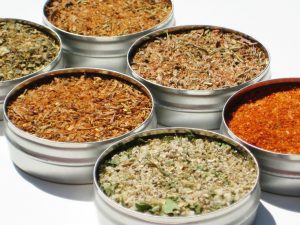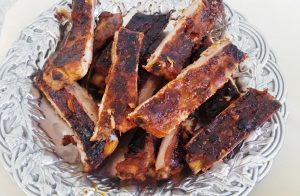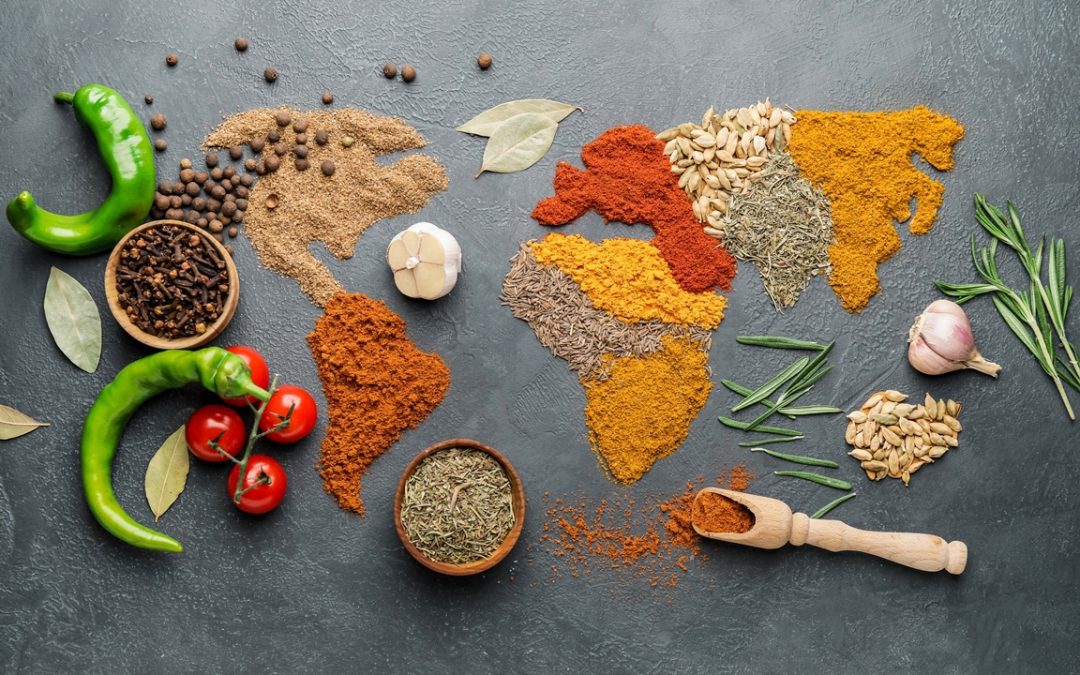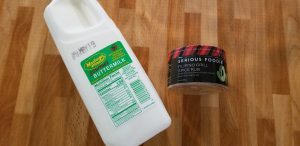Want to learn about dry rubs/seasoning blends like a professional chef? Just in time for grilling time, we explore why & when you will want to use dry rubs/seasoning blends. Dry rubs/seasoning blends are by far the most widely used flavoring agents around the world. But it’s not only about grilling…
Let’s start with the Serious Foodie Top 10 List of Using Dry Rubs & Seasoning Blends:
- Dry Rub Marinade: OK, so this is the obvious first choice. And almost every grill culture around the world will use dry rubs to prepare meats. See below for an abbreviated master class on using dry rub marinades.
- Finishing: After you’ve grilled, braised, stewed, sauteed, sous vide, your meat, poultry, fish, or veggie – then adding another dose of seasoning will really wake up all the flavors, and give a bold spark to any dish. In fact, this is how most of the world uses spice blends: think curries of India and Africa, za’atar of the Middle East, or dukkah of Northern Africa.
- Popcorn and other snacks: The first, and easiest, way to enjoy almost any spice or spice mix is to dust a little on freshly-popped popcorn, or coat some nuts and/or snacks with a spicy mix. We’ve previously done a full report on using seasonings with popcorn (HERE) and shared a fool-proof easy recipe on honey-roasted snack mix.
- Roasted vegetables: Another easy way to play with a spice mix is to toss it with roasted vegetables. I usually do this after roasting, not before, so the spices don’t scorch in the oven. It’s the basic seasoning salt idea – only pumped up a notch with more interesting spices. Check out our recipe for West African rosemary potatoes.
- Stirred into stews, braises, or soups: Add a pinch of spices to the liquid as it is simmering. Then add more if you find you love the flavor, right before serving.
- Egg salad: Curried egg salad is a thing for a reason; it’s really good! Try other spices in egg salad, too; we love using our spicy blends, like Moroccan, TexMex, or Filipino.
- Salad dressings: I like to add a pinch of spices to a basic vinaigrette. A lemon vinaigrette with just a touch of Asian Fusion (South Indian) blend, or Moroccan blend becomes something very special.
- Baked or mashed potatoes: Sprinkle Asian Fusion, garam masala or curry powder over a hot baked potato and add some cilantro and yogurt for an Indian-inspired dinner.
- Hummus: There is a lot of great artisan made hummus in most super markets, and there are some outstanding flavors. We keep a container of our favorite plain hummus in the fridge all the time. It’s a healthy, quick snack – and it can be pumped up a notch with some seasonings, like Japanese togarashi, the dukkah from Egypt/Northern Africa, or the Serious Foodie Chinese spice blend.
- Cocktails: Yep – toss out those one-note glass rimmers, and try something completely different. Use the Kentucky Bourbon to rim a glass for a Manhattan or Old Fashion. Spice up an already spicy Margarita with the Serious Foodie TexMex spice blend. Or, try rimming a glass with the Asian Fusion Spice blend, then pour in the amazing Asian Lychee Martini.
So, we thought you’d like to hear about some of the facts behind the technique of rubs. This article we run through dry rubs, which can be so important for grilling and roasting – and help you think outside the box (or dry rub jar, in this case). Make sure you read to the end – we have some creative idea on using spice rubs.

A Serious Foodie Primer on Using Dry Rubs – More than Just Meat
Why Use Dry Rubs?
Dry rubs are simple, versatile, and cheap – even when you buy a pre-made rub rather than collecting all the spice ingredients to make from scratch. Home made versions are easy to prepare, but a commercial version may have ingredients that are harder to find. Or, you just don’t want extra spices hanging around in your cupboard.
Spice rubs/blends are used around the world to impart a lot of flavor to grilled meats, casseroles, and stews – and are often used instead of salt. They can be stored at room temperature for long periods of time, and do not take up much space. Another great thing about dry rubs is that you can impart a lot of flavor without much work and without much added calories. The typical dry rub from Serious Foodie adds between 5 to 10 calories per serving. Not much, considering that the average BBQ sauce can add about 100 to 200 calories per serving.
The Basics for Using Dry Rubs for Grilling:

A man with a barbecue plate at a party between friends. Food, people and family time concept.
Ask ten people about how to use dry rubs/spice blends – and you’ll get at least five different answers and maybe five blank stares. Even among professional chefs there is plenty of confusion on how and when to use a dry rub versus a brine or wet marinade. Then, after you dry rub to get a bunch of flavor into your favorite protein, comes the important question: should you sauce or not?
Like marinades and brine, timing is everything on when you apply a dry rub. Follow these principles, and you will always get a great result.
Dry Rubs Are As Easy As 1, 2, 3:
- Rub & Wait & Refrigerate
- Warm to Room Temperature, Then Cook
- Add a Sprinkle of Dry Rub (as the meat rests)
- (Optional) Add Sauce near the end of cooking.
When using any dry rub, make sure you pat the main ingredient to remove excess surface moisture with a clean towel (meat, fish, or vegetables). Be very generous when applying a rub – and, as the name implies, rub the ingredients gently into the meat, fish, or vegetable.
***THIS IS THE VERY IMPORTANT MASTER CLASS STEP: Tightly wrap the dry-rubbed meat, fish, or vegetable with plastic wrap (nothing else will really work). Put your protein into a container, placing it in the refrigerator for 2-4 hours at least. Overnight is best.
How a Dry Rub Works
If you see liquid below your meat, fish, or vegetable – don’t worry! This is exactly what needs to happen. The moisture from the meat, fish, or vegetables is drawn out by the spice blend (dry stuff absorbs water – right?). The spices and liquid combine, then are reabsorbed back into the meat, fish, or vegetable over time. That is why you need to wrap tightly, and why you need to wait at least 2 hours. The surface remains moist enough to readily take in the flavor of the grill smoke, or the cooking sauce (if you go in that direction – see below).

Dry Rubbed Chicken Legs
In some instances, a dry rub alone works without a grill or finishing sauce – as long as you use a very flavorful rub, and use a trick or two. When you are roasting a chicken, make sure you loosen the skin to place a bit of rub under the skin as well as rubbing top and bottom. If you are grilling, sprinkle a bit of the dry rub over the finished product right before serving to kick up the flavor a bit. We even tried a dry rub on a store bought, pre-roasted chicken. You’ll be amazed that the flavors permeated the meat after only a few minutes.

Moroccan Chicken
Rub & Sauce Combos
You can easily mix and match dry rubs with your favorite grilling or finishing sauces – a bit of fresh tomato sauce on Italian dry rub grilled chicken, Serious Foodie Hatch Chile Sauce on fried fish fillets flavored with the Serious Foodie TexMex dry rub, or a nice Serious Foodie Korean Grill Sauce on Serious Foodie Asian rubbed pork loin. Be creative with your combo – Serious Foodie Damien did a great job with Filipino Spice Rubbed Grilled Pork (click HERE for the recipe) combined with Indonesian Sambal crema on tacos! Yum!
Add a dry rub to a brine for added flavor. We added the Serious Foodie Filipino Grill Rub to a standard buttermilk overnight brine on chicken. All that wonderful flavor was just soaked up by the meat. We then grilled the chicken without a sauce – moist, amazing flavor in every bite. There were no leftovers.
A few words of wisdom: (1) If you use a dry rub, just be careful of the salt and sugar you are adding with the sauce. You don’t want everything tasting like a salt lick, or a candy bar. (2) The only other issue is when you apply the sauce – our rule of thumb is always near the end of cooking, and less is better. Have some sauce off to the side to dip if folks want more.

Asian Rubbed Ribs with Korean Grill Sauce
And Now for Something Completely Different…
How about bumping up the flavor of salads? Use a spice rub/spice blend as a seasoning salt. We love the Asian Ramen Salad by Alyssa Rivers, and it’s even better when we sprinkled some of our Asian Fusion rub onto the salad.
Popcorn. We love popcorn. We eat it almost every day. So, it’s easy to get bored with the same old flavors. We show how you can use spice rubs to really pump up the flavor of popcorn – so easy, so yummy. Check it out HERE.
Cocktails. It’s not a new idea to rim a glass with some sugar, salt, or a spice blend – anyone for a margarita? – but you can really add some unique flavor to your favorite adult drink with some spice rubs. Infuse some vodka with a spice rub: take about 1 tablespoon per cup of alcohol, allow to sit at room temperature for 2- 3 days, then strain. Want spicy? Use TexMex. Want exotic? Infuse with Filipino Grill Rub. Want to up your coffee cocktail? Use a Seattle Espresso-infused vodka.




